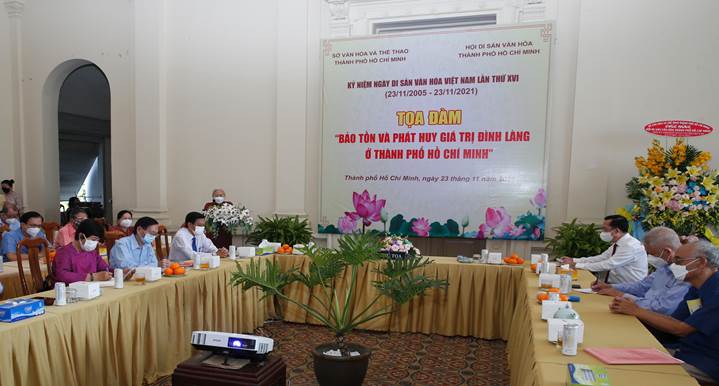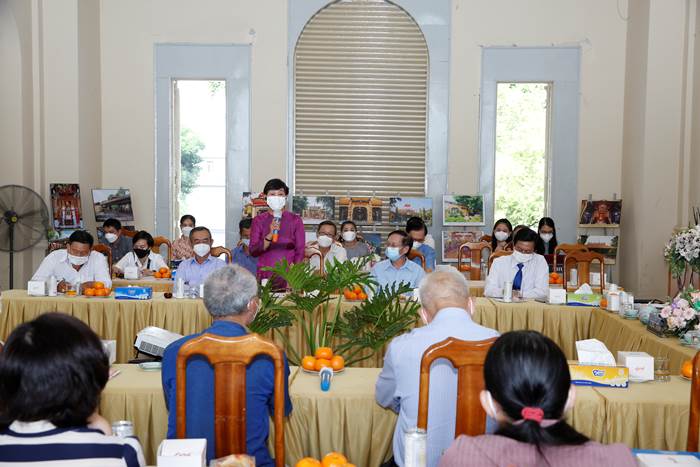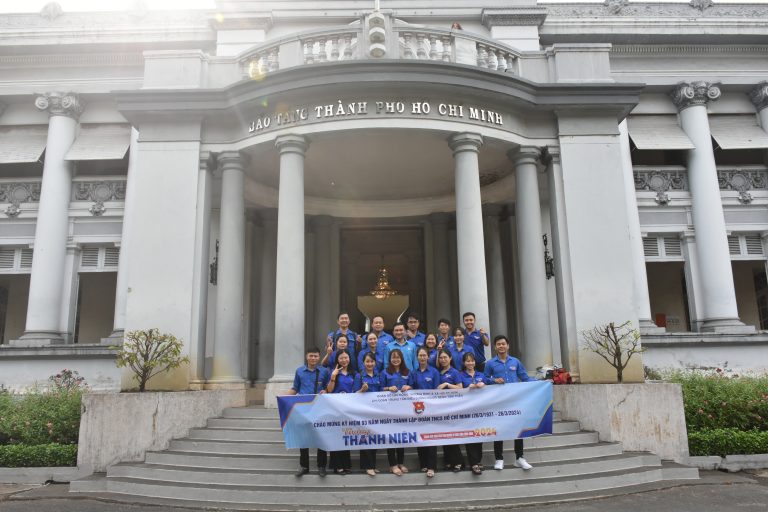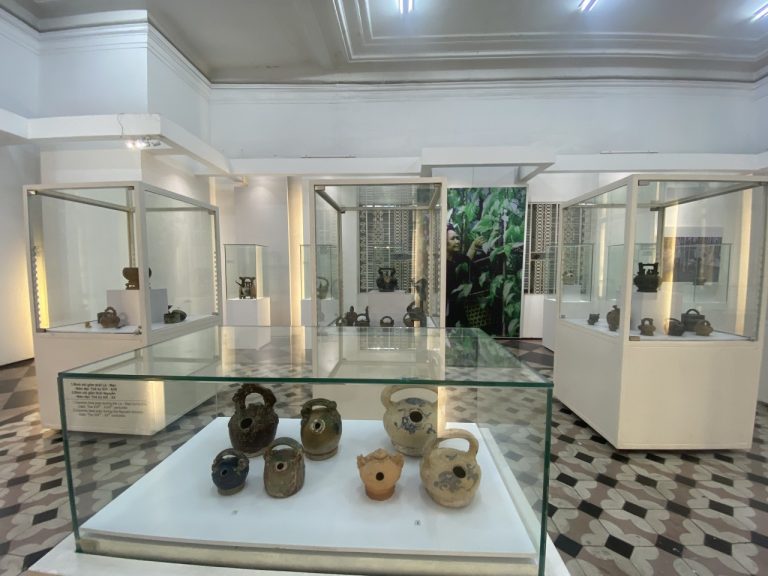The communal house is the traditional symbol of Vietnamese villages. Communal house was formed in Ho Chi Minh City and the Southern region as an indispensable need for culture and beliefs of the Vietnamese exiles in the early days of reclamation and establishment of hamlets. The communal house architectural heritage serves as a “witness” to the history of the city’s formation and development, reflecting the art of architecture, folk sculpture, and educating the fine traditions of the nation. The communal house has become a symbol of faith and community cohesion, the people’s aspiration for a prosperous and happy life in the new land. In the minds of many children who grew up in the countryside, the communal house evokes memories of childhood, the simplicity of the homeland, where there are family, friends, and peaceful days. memorably smooth. Ho Chi Minh City today has become an urban place from the villages of Gia Dinh province, so it has preserved more than 300 communal houses after more than 300 years of establishment and development. According to the flow of time and urban development, the role and position of the communal house gradually disappears in modern society, so the preservation and promotion of the value of the communal house in the current period is a problem. subject that needs attention.
On November 23, 2021, Department of Culture and Sports; The Cultural Heritage Association of Ho Chi Minh City held a Celebration of Vietnam Cultural Heritage Day and held a seminar: “Preserving and promoting the value of communal houses in Ho Chi Minh City” for the purpose of meeting and exchanging between scientific researchers and managers about the preservation and promotion of the values of the communal house; at the same time, propose solutions to contribute to preserving and promoting the value of communal houses in Ho Chi Minh City. The interest, participation and exchange of researchers, managers, the Executive Board, the Board of Trustees, etc., have overviewed the history, architecture, role and values of the communal house in daily life. community; is experience and solutions to preserve and promote the value of communal houses in contemporary society, especially the conservation and promotion of communal communal values in Ho Chi Minh City in the current period.
Through the content exchanged and discussed at the Seminar, it has once again confirmed the importance of the village communal house in the cultural life of the community with special values of history, culture and architecture. The village communal house is not only a place to worship the village God Thanh Hoang, but also a meeting place to solve village affairs, a place to organize festivals and cultural activities of the Vietnamese village community that has existed for a long time. Most of the communal houses in Ho Chi Minh City have been established for a long time, with a lifespan of over 100 years, and some of them are over 300 years old.

Chair of the Talk: Mr. Tran The Thuan – Member, Director of Department of Culture and Sports
and Ms. Le Tu Cam Chairman of the City Cultural Heritage Association

Ms. Le Tu Cam – President of Ho Chi Minh City Cultural Heritage Association
Opening speech of the Dialogue
The cultural value of the village communal house, including the tangible cultural value, is the communal house with artistic architecture imbued with national identity, the unique identity of Southern communal house architecture. The architecture of the communal house is very simple, close to the old houses of the people, and contains sophisticated and unique sculptural art. The large, mossy, tiled roof set reminds us of the use of tools in the reclamation period, so it has been beautifully decorated. The communal house is not only a symbolic architectural work of the whole village, but also contains the historical stories and aspirations of the people conveyed through each architectural line and carving. Inside the communal house, there are large wooden pillars with paintings of Bao Lam, Hoanh Phi, and the juxtaposed with carvings of the quartet (dragon, ly, turtle, phoenix) and the animals present in the Southern land and many sophisticated motifs. like clouds, flowers,

Architects. Khuong Van Muoi – Former Vice President of Vietnam Association of Architects
Speaking at the Talks
For the Southern region in general and Ho Chi Minh City in particular, the communal house always carries with it a certain diversity and richness but is always unified in the common culture of the nation. Communal house becomes an important cultural, spiritual and religious symbol in village life, is one of the important institutions and community house, where worships the village guardian deities. The communal house has penetrated deeply into the thoughts and feelings of each people, greatly contributing to preserving the solidarity and community cohesion, is a symbol of faith and community cohesion, is the aspiration of the people. people about a prosperous and happy life in the new land, a base for gathering and nurturing cadres, a revolutionary base in the two resistance wars against the French and against the US, a place to gather the People, propagate, mobilize the people to join the revolution. Along with the values of tangible heritage, The village communal house also preserves the intangible cultural value that is the custom of worshiping God Thanh Hoang and other gods – and that is the festival program of worshiping God – Ky Yen ceremony. The communal house is the place that most clearly shows the close-knit community life of the Vietnamese people. That shows from the process of building the house. In order to build a communal house, local people must join forces and contribute money to build a communal house over a period of many years. They divided each other into groups of workers, each group was assigned a certain job. They work together, try their best to show their talents, then talk, respond, share… The village love has also grown stronger since then.

Dr. Nguyen Thi Hau – Former Deputy Director of the City Development Research Institute, Deputy General Secretary of the Vietnam Historical Science Association, General Secretary of the Ho Chi Minh City Historical Science Association spoke at the Seminar
Talking about the current situation, the delegates said that, along with the advantages and values of communal houses in community life, communal houses in Ho Chi Minh City also face difficulties and challenges when the villages The family is showing signs of deterioration, has not been repaired in time or is temporarily repaired not according to regulations, deforming the monument, “concreting” the monument. Some buildings that have been demolished and rebuilt or replaced with other structures are examples of behavior that is incompatible with the heritage. Due to the process of urbanization, some communal houses have been narrowed in space, the premises are quite narrow. The problem is to consider and have a reasonable solution between conservation and development. The encroachment of relic space by surrounding residential areas is seriously threatening the existence of communal houses. Family space is changed, The village communal house is gradually losing its inherent important function. Existential documents and even the identity of some communal houses have been lost due to the ineffective preservation of the information storage system of the monument, which is mainly based on experience; Technical documents such as drawings or detailed records of construction techniques or descriptions of architectural changes are incomplete, etc., making it difficult to propagate and promote the values of the communal house. In particular, the budget for activities of the communal house is still limited, not enough to protect and promote the heritage value of the communal house. Technical documents such as drawings or detailed records of construction techniques or descriptions of architectural changes are incomplete, etc., making it difficult to propagate and promote the values of the communal house. In particular, the budget for activities of the communal house is still limited, not enough to protect and promote the heritage value of the communal house. Technical documents such as drawings or detailed records of construction techniques or descriptions of architectural changes are incomplete, etc., making it difficult to propagate and promote the values of the communal house. In particular, the budget for activities of the communal house is still limited, not enough to protect and promote the heritage value of the communal house.
At the discussion, the delegates proposed many measures to preserve and promote the value of the communal house. These include issues such as: Building regulations general and synchronous management of communal communal house cultural heritage, avoid overlapping of functions and tasks, and at the same time standardize information on communal communal house relic. Upholding the role of the residential community and identifying this as the responsibility of the whole society and the whole political system; Conservation should not be the work of experts alone, but should involve the community. The participation of the community in the conservation and preservation of heritage needs to be affirmed as a prerequisite. Bringing the village communal house into the cultural and spiritual life of the people, prioritizing the organization of community cohesion activities to enhance the value of the communal house while contributing to the preservation and promotion of the relic value. Continue to pay attention to training human resources who are professional, enthusiastic and responsible; organize classes to equip knowledge about communal house culture, on the work of preserving relics for all cultural officials in the districts, Thu Duc city and the Management Board of communal houses in Ho Chi Minh City. Restoration and embellishment of relics on the basis of restoring values from the original. Promoting socialization in the restoration of communal house relics because the work of restoring and embellishing communal houses also involves a greater meaning, which is the study of preserving and promoting the values of the relic. Paying attention to the restoration of cultural space of communal houses, exploiting typical festivals to become intangible heritages. Strengthen communication and education for local people about preserving and promoting the values of communal houses: Compiling content to introduce the value of relics to agencies, units and communities the people or put it in the tourist handbook of the districts and city of Thu Duc; gather communal houses into a common house for activities, exchanges, propaganda and orientation activities; Building a database of communal houses contributes to quick and accurate access to information about communal houses. Strengthen timely monitoring of the status of communal houses, especially the role of local communities, as history has shown that prior to the advent of conservation theories and the involvement of specialized agencies, In the field of conservation, the local people have preserved the communal house quite well for hundreds of years.
Articles and photos: Museum of Ho Chi Minh City





